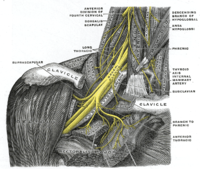
Photo from wikipedia
To investigate the feasibility of both needle electromyography (EMG) and proximal nerve conduction studies (NCS) in predicting C5 palsy after posterior cervical decompression. This study included 192 patients with cervical… Click to show full abstract
To investigate the feasibility of both needle electromyography (EMG) and proximal nerve conduction studies (NCS) in predicting C5 palsy after posterior cervical decompression. This study included 192 patients with cervical myelopathy undergoing laminoplasty or laminectomy. Preoperatively, all patients accepted bilateral needle EMG detection and proximal NCS that consisted of supramaximally stimulating Erb’s point and recording compound muscle action potential (CMAP) from bilateral deltoid. In the present study, 11 (11/192, 5.7%) patients developed unilateral C5 palsy after operation, and more patients with C5 palsy showed abnormal spontaneous activity in C5-innervated muscles compared to those without C5 palsy (8/11 vs. 16/181, p < 0.05). The sensitivity and specificity of spontaneous activity in C5-innervated muscles in predicting postoperative C5 palsy were 72.7% and 91.2%, respectively. Furthermore, there were significant left-to-right differences of deltoid CMAP amplitudes between the patients with and without C5 palsy (p < 0.05), and this measurement was also demonstrated to be useful for distinguishing patients with C5 palsy from cases without C5 palsy by receiver operating characteristic (ROC) curve analysis (cut-off value: 2.1 mV, sensitivity: 63.6%; specificity: 95.0%). In addition, the sensitivity and specificity of a series application of these two measurements were 63.6% and 100.0%, respectively. The findings of this study support the hypothesis that pre-existing progressive C5 root injury may be a risk factor for C5 palsy after posterior cervical decompression. Clinically, the estimation of NCS and needle EMG in C5-innervated muscles may provide additional useful information for predicting C5 palsy after cervical spinal surgery. Diagnostic: individual cross-sectional studies with the consistently applied reference standard and blinding.
Journal Title: European Spine Journal
Year Published: 2021
Link to full text (if available)
Share on Social Media: Sign Up to like & get
recommendations!